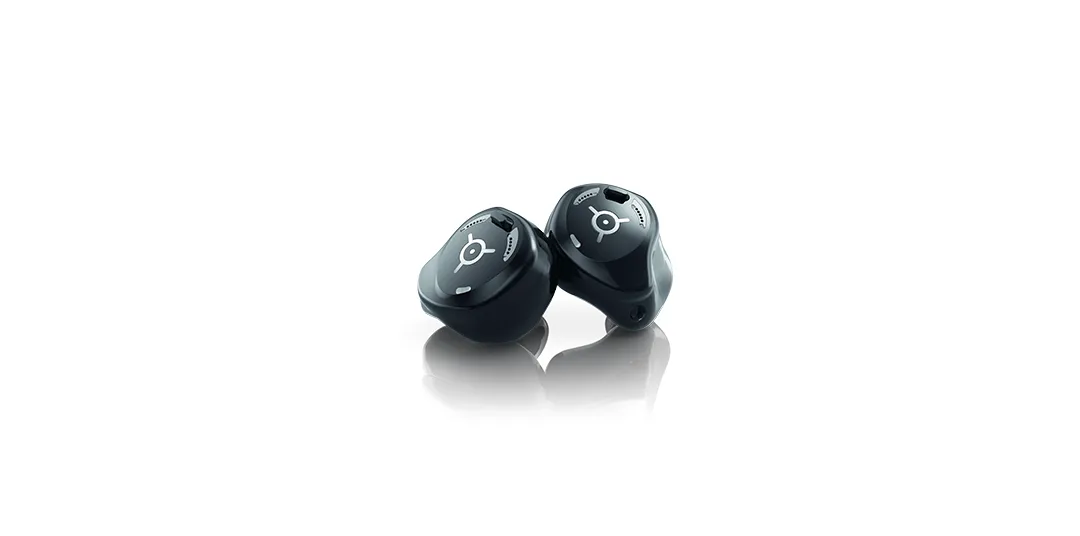Hearing aid batteries
Below you will find the information you need to make buying and changing your batteries as straightforward as possible.
Hearing aids are becoming increasingly smaller and more powerful, regardless of whether they run on standard or rechargeable batteries. While a rechargeable battery can be regularly charged, standard hearing aid batteries will need to be replaced. In general, when deciding on which battery to buy, it is worth taking the following into consideration: type, performance, manufacturer, service life, quality, and capacity. Below you will find all the information you need to make buying and changing your batteries as straightforward as possible, allowing you to get the most out of your hearing aid.
How do hearing aid batteries work?
In the past, mercury zinc batteries were the most commonly used. Recently, however, zinc-air batteries have gained in popularity, as they are more eco-friendly and maintain a constant voltage. They have a simple operating principle: Small holes are integrated into the battery surface, which allow the air to penetrate. The air reacts with the zinc inside the battery, producing zinc oxide. The reaction generates energy.
It is important to note that the process only begins once the battery has been inserted into the hearing aid. This is why the holes in hearing aid batteries are sealed with special protective foil.
Before you insert the battery into the hearing aid, please remove the foil. Since the battery only begins to work at this point, it may take a few moments before your hearing aid is supplied with power.
It is worth remembering that once the protective foil has been removed, it is impossible to stop the battery discharging. You should therefore remove the foil from your hearing aid battery only when you are ready to insert into your hearing aid. Alternatively, it can also be a good idea to remove the protective foil and wait for two minutes before inserting the battery into your hearing aid.
Rechargeable batteries: The alternative to hearing aid batteries
Hearing aids don’t always have to be powered by standard, disposable batteries. Rechargeable batteries are an alternative option. One advantage of rechargeable batteries is that they don’t need to be changed or disposed of. Once the battery runs out, it can be recharged overnight. Your local professional will be happy to explain which hearing aid models come with rechargeable batteries, and whether they would be appropriate for your hearing situation.
How many hearing aid batteries do I need?
You need one hearing aid battery per hearing aid.
How often do I have to change my hearing aid batteries?
How often you change your battery depends on the size of the battery and the performance of your hearing aid. A size 10 battery in a digital hearing aid with many control functions generally lasts three to five days, while a larger, size 13 battery in a hearing aid with simple functions can last for up to three weeks. The battery service life also depends on how long you wear the hearing aid.
Are there different types of hearing aid batteries?
Hearing aid batteries are produced by various manufacturers and come in a variety of sizes. Behind-the-ear (BTE) hearing aids typically take size 13 and 312 batteries, while in-the-ear (ITE) hearing aids tend to take size 312 and size 10.
The more powerful size 675 battery is used in larger models, as it provides a higher energy supply for longer.
What size do I need?
If you want to order more batteries but are unsure what size you need for your hearing aid, the old packaging can be helpful. Hearing aid batteries come in four sizes: 10, 13, 312, and 675. Don’t be confused by the additional codes, such as A, PR, S, ZD, ZA, V, DA, or ZL – these are less important. The size can be found on the front of the packaging, on the right, highlighted with the relevant color.
If you no longer have the hearing aid battery packaging, you can easily find out what size you need. Batteries come in different diameters and heights. The table provides the information you need.
Hearing aid type | Color code | Diameter | Height | Capacity | Voltage |
|---|---|---|---|---|---|
| 675 | Blue | 11.6 mm | 5.4 mm | 650 mAh* | 1.4 V |
| 13 | Orange | 7.9 mm | 5.4 mm | 310 mAh | 1.4 V |
| 312 | Brown | 7.9 mm | 3.6 mm | 180 mAh | 1.4V |
| 10 | Yellow | 5.8 mm | 3.6 mm | 100 mAh | 1.4 V |
*mAh = milliampere hours
How do I insert the batteries?
When fitting the small hearing aid batteries, the first step is to remove the adhesive foil. It is then advisable to wait for two minutes to allow the battery to reach its full power. Please ensure that you insert the batteries with the minus and plus sides the right way round. If the battery compartment will not close, or is difficult to close, it is usually because the battery has been inserted incorrectly.
If your hearing aid does not work even after fitting a new battery, ensure that there is no contamination in the battery compartment, as this can interfere with the connection. Many manufacturers supply magnetic tools to make battery fitting easier.
How do I store hearing aid batteries?
Batteries should be kept neither in the refrigerator, nor in the full sun. They should ideally be stored at room temperature, between 10 and 25°C. They should also be kept out of the reach of children, as button cells are small enough to be swallowed.
As soon as the hearing aid batteries run out, remove them from your hearing aid to prevent them from leaking or expanding.
How should I dispose of the batteries?
Standard hearing aid batteries are not rechargeable. Please do not throw your used button cells in the garbage. Help us reduce the number of hearing aid batteries that end up in landfills by participating in our free battery recycling program!
We know you go through a lot of hearing aid batteries in a year and to remedy this, we partnered up with a leader in environmental conservation, to recycle your hearing aid batteries in accordance to the Canadian transportation and environmental regulations. Participating in this free service couldn’t be easier!
If you are a Connect Hearing customer, you can pick up a free Little Green Box at your nearest participating clinic.
Assemble your Little Green Box.
Fill it with used hearing aid batteries, and then return it to your Connect Hearing clinic for safe transport and recycling. They will supply you with a new, empty box.
Other Topics
VAC, WCB, WSIB, WorkSafeBC, ADP & ODSP accepted. *Hearing evaluations/tests are free for customers over the age of 18. Fees may apply where specific testing for employment purposes, reports, a copy of your results or the completion of an application is required. See clinic for full details.





